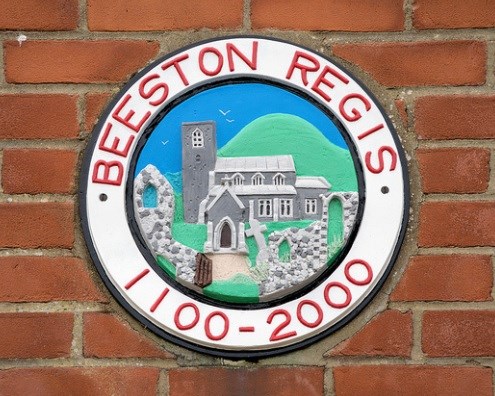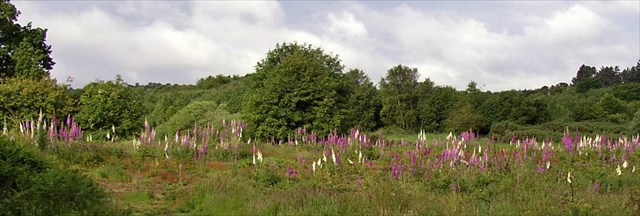
The circular plaque features the local chu rch and ruined Priory of St Mary’s, with Beeston Hill (known locally as Beeston Bump) rising behind. The dates 1100 -2000 are shown on a ring surrounding the main image and mark 900 years of habitation in the area.
The village is about a mile east of Sheringham, and 2 miles west of Cromer. According to the 2011 census it had a population of 1,062. The North Sea is the northern boundary of the parish, and the wooded Beeston Heath rises up from the parish to form the southern boundary.
Beeston Regis was once known as Beeston-next-the-Sea, but from 1399 when Henry Bolingbroke, Earl of Lancaster, became King Henry IV, the name became Beeston Regis. Regis means "of the king", and the living and manor of Beeston became part of the Crown and the Lancaster Inheritance.
Evidence of Roman habitation was found on Beeston Regis Heath in 1859 when a complete set of quern-stones were found dating from Roman times. Quern-stones were used to grind materials, the most important of which was usually grain to make flour for bread.
Nearby is Beeston Common, consisting of 24.7 hectares/61 acres of grassland, heath, marsh, fen and secondary woodland. The common was made a Site of Special Scientific Interest in 2000 and is the habitat for a wide range of mammals, birds, and insects. There are some forty species of rare flowering plants, and fourteen species of British orchids have been recorded on the common due to its special soil conditions. With such a variety of flowers the site is attractive to butterflies.
In November 2007 the Dew pond was reinstated on the top common by Sheringham Town Council. Many years ago there were shallow ponds on this part of the common and in 1939 Natterjack toads were recorded in and around the ponds along with Common and Great Crested Newts. The reinstatement is an attempt to attract more wildlife back to this part of the common. Until the Second World War, goats, ponies and geese were a common sight grazing in and around the ponds.
The Back common, although not as species-rich as the Site of Special Scientific Interest to the south of the Cromer Road is home to a great many plants and insects. In the late spring and early summer the common is as mass of buttercups. Along the edges of Beeston Beck and Sheringham Loke, Monkey Musk grows in abundance and until to a few years ago dittander, a rare plant, was present.

On Beeston Regis Heath there are circular pits called 'Hills and Holes'. They are thought to date from prehistoric times. During the Saxon-Norman to Medieval periods these pits were dug to obtain iron ore, which was then smelted in a furnace to produce iron.
During the Second World War Beeston Bump was the location for a top secret listening station. These stations were called Y stations and were the ears of the War Office’s Bletchley Park, code name station X. The octagonal concrete base of this top secrete facility can still be seen on the summit of the hill.

There is a legend told in East Anglia about a ghostly black hound from hell that is said to roam the coast and lonely lanes of Norfolk. The hound is said to be the size of a small Horse and appear from the depths of Beeston Bump with malevolent flaming red eyes. Anyone who is confronted with the Doom Dog it is said will be dead with-in one year of their encounter. The legend was the inspiration for Sir Arthur Conan Doyle who wrote the book The Hound of the Baskervilles. Conan Doyle had been on a Golfing Holiday at the near-by Links Hotel in West Runton, and it was in the sitting room of the Hotel that his friend, Bertram Fletcher Robinson recounted the legend of the Black Hound from the Bump.
You are looking for a small black vial which contains a log only. You will need to bring your own pen. Parking is limited at GZ but there is ample parking in Britons Lane which is just a short stroll away.
**************************************
If anybody would like to expand this series please do. I would just ask that you let SmokeyPugs know first so they can keep track of the Village Sign numbers and names to avoid duplication..
*************************************